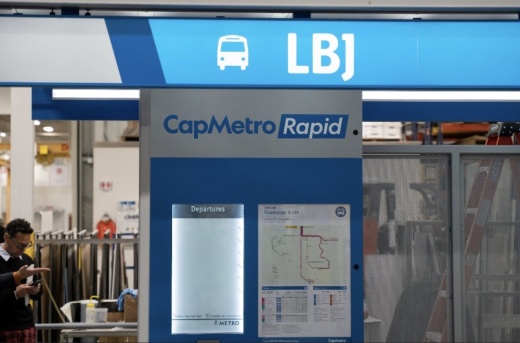What is the MetroRapid project?
CapMetro’s two transit lines—Pleasant Valley and Expo Center—are among the first services to be realized in Project Connect. The Pleasant Valley line will run from the Mueller neighborhood in Northeast Austin to the Goodnight Ranch neighborhood in Southeast Austin. The Expo Center line will run from The Travis County Exposition Center located on Decker Lane to downtown.
The high-frequency transit lines will run about every 10 minutes and be served by fully electric buses. While CapMetro already has around a dozen buses in its normal rotation, the MetroRapid will be its first fully electric project.
The project broke ground in late 2021 and was originally slated to open this summer.
Why is it being delayed?
CapMetro CEO Dottie Watkins said the delay is due to a variety of factors, including unexpected challenges using all-electric buses, shipping delays and infrastructure changes.
Watkins said their original assumption was depleted buses would be swapped out with buses being fully charged at a depot.
However, after scheduling routes and consulting with national experts, CapMetro realized, to accommodate depot-only charging, they would need twice as many buses. CapMetro has 40 buses planned for the route and would need to get just shy of 80, Watkins said.
Watkins said doubling its bus inventory would have been “exorbitantly expensive,” as each electric bus costs roughly $1 million.
To cut costs, CapMetro decided to install overhead charging stations at the end of each route that will top buses off throughout the day. However, that plan requires CapMetro to acquire more land at Pleasant Valley and the Travis County Expo Center. The pivot will also require CapMetro to build its Park & Rides—parking lots where travelers can park their cars and hop on a CapMetro bus—sooner than anticipated.
CapMetro originally planned to unveil the MetroRapid lines first and then build the Park & Rides later, Watkins said.
“But with the end of line charging, we actually need to have the land acquired and the Park & Ride constructed to [account for the space] of the charging facility,” Watkins said.
Watkins said the MetroRapid plan got more complex after CapMetro and the city of Austin identified the need for shared-use paths along the corridor that would better accommodate bicyclists, pedestrians and people with disabilities.
“We had intended to build pretty basic bus stops—behind the car bus stops—like we do throughout the city,” Watkins said. “[But the shared-use paths are] an enormous benefit to our riders.”
However, building the shared-use paths will push the bus stops into the street, requiring the roadways along the transit line to be reconfigured, Watkins said. Further, some of the water lines on the construction site are old and shallowly buried, she said.
“So there [is] a need to do an in-depth assessment at every location to figure out if the waterline here is deep enough and young enough to tolerate having a bus stop built on top of it without causing a problem for that infrastructure,” Watkins said.
As construction goes on, old water lines will be upgraded and/or buried deeper, Watkins said.
Even if all of these construction hurdles disappeared, the MetroRapid would still have been delayed until the end of 2023 due to supply chain issues with CapMetro’s electric buses, Watkins said.
“We've learned a lot about what it takes to operate electric buses, and this end of the line charging strategy has been an important lesson learned,” Watkins said.
Does the project have funding?
Watkins said funding for the rapid lines is secure. CapMetro is counting on 65% of funding to come from the Federal Transit Administration, and the remainder of the project will be taken care of through an interlocal agreement CapMetro and the Austin Transit Partnership signed in summer 2021.
“The funding is in good shape; it's really just a matter of getting all of the pieces lined up and ready to go,” Watkins said.
Why electric buses?
Converting CapMetro’s bus fleet to battery electric buses is part of the organization's sustainability vision plan, which includes a goal of going carbon neutral by 2040. Further, Watkins said the MetroRapid project will place Austin in the top percent of cities using electric buses for public transportation.
Although electric buses cost more up front than diesel buses, Watkins said they are a worthwhile investment.
“When you project out what you think it's going to cost over the life of the bus, you actually break even, if not save money, because the cost of electricity is generally much less than the cost of fossil fuels,” she said.
Watkins said the biggest setback with electric buses is range. Electric buses can reliably go 150 miles before needing to be recharged, whereas diesel buses can go almost 300 miles.
“We have learned a ton in the experience of both operating electric buses as well as modeling these particular routes. We're much further advanced in our overall planning for implementing a better electric bus fleet than we were when we first got the project,” Watkins said.





